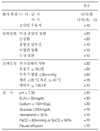Community Acquired Pneumonia
Article information
J Korean Med Assoc. 2004;47(11):1075-1098
Publication date (electronic) : 2004 November 30
doi :
https://doi.org/10.5124/jkma.2004.47.11.1075
Abstract
Community acquired pneumonia is a common disease, and it is usually managed by empirical antibiotics therapy from several management guidelines. It is challenged by emergence of drug resistant bacterial strains, especially Streptococcus pneumoniae and recent increasing recognition for the mixed infection by atypical pneumonia pathogens such as Mycoplasma, Chlamydia and Legionella species. Even though community acquired pneumoniae caused by drug resistant S. pneumoina is common in Korea, the treatment results are good with current antibiotics. This review deals with important new findings and management issues of community acquired pneumonia in immunocompetent adults.
Keywords: Community acquired pneumonia
References
1. American Thoracic Society. Guidelines for the initial management of adults with community-acquired pneumonia: Diagnosis, assessment of severity, and initial antimicrobial therapy. Am Rev Respir Dis 1993. 1481418–1426.
2. American Thoracic Society. Guidelines for the management of adults with community-acquired pneumonia:Diagnosis, assessment of severity, antimicrobial therapy, and prevention. Am J Respir Crit Care Med 2001. 1631730–1754.
3. Bartlett JG, Dowell SF, Mandell LA, File TM, Musher DM, Fine MJ. Practice guidelines for the management of community-acquired pneumonia in adults:Guideline from the Infectious Diseases Society of America. Clin Infect Dis 2000. 31347–382.
4. Mandell LA, Bartlett JG, Dowell SF, File TM, Musher DM, Whitney C. Update of practice guidelines for the management of community-acquired pneumonia in immunocompetent adults. IDSA guidelines. Clin Infect Dis 2003. 371405–1433.
5. Swartz MN. In : Fishman AP, Elias JA, et al, eds. Approach to the patient with pulmonary infections. Fishman's Pulmonary diseases and disorders 1998. 3rd edth ed. New York: McGraw-Hill; 1905–1937.
6. Donowitz GR, Mandell GL. In : Mandell GL, Bennet JE, Dolin R, eds. Acute pneumonia. Principles and practice of infectious diseases 1995. 4th edth ed. New York: Churchill Livingstone; 619–637.
7. Bartlett JG, Mundy LM. Community-acquired pneumonia. N Engl J Med 1995. 3331618–1624.
8. Pomilla PV, Brown RB. Outpatient treatment of community-acquired pneumonia in adults. Arch Intern Med 1994. 1541793–1802.
9. Brown PD, Lerner SA. Community-acquired pneumonia. Lancet 1998. 3521295–1302.
12. Stout JE, Yu VL. Legionellosis. N Engl J Med 1997. 337682–687.
13. Sanford JP, Gilbert DN, Sande MA. The Sanford guide to antimicrobial therapy 1999. 29th edth ed. Vienna(VA, USA): Antimicrobial Therapy Inc.;
16. Choi EH, Lee HJ. Clinical outcome of invasive infections by penicillin-resistant Streptococcus pneumoniae. Clin Infect Dis 1998. 261346–1354.
17. Song JH, Jung SI, Ki HK, Shin MH, Ko KS, So T, et al. Clinical outcomes of pneumococcal pneumonia caused by antibiotic-resistant strains in Asian countries:a study by the Asian network for surveillance of resistant pathogens. Clin Infect Dis 2004. 381570–1578.
18. Feldman C. Clinical relevance of antimicrobial resistance in the management of pneumococcal community-acquired pneumonia. J Lab Clin Med 2004. 143269–283.
Article information Continued
Copyright © 2004 Korean Medical Association







